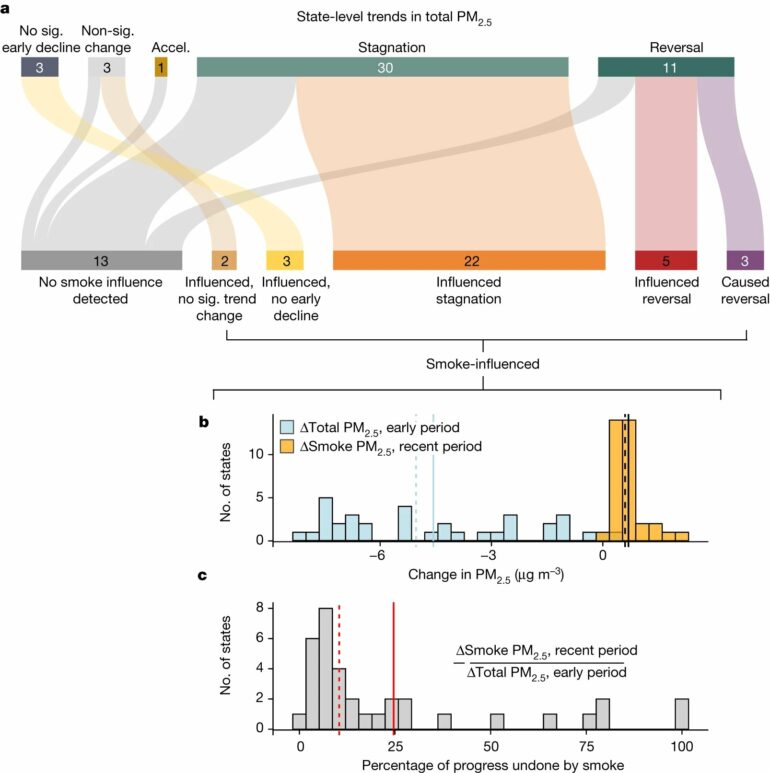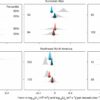Stanford research reveals the rapidly growing influence of wildfire smoke on air quality trends across most of the United States. Wildfire smoke in recent years has slowed or reversed progress toward cleaner air in 35 states, erasing a quarter of gains made since 2000.
By spewing plumes of smoke laden with tiny toxic particles called PM2.5, wildfire smoke has slowed or reversed progress toward cleaner air in dozens of U.S. states, Stanford University researchers have found.
“We document a growing source of pollution that is changing trends in overall PM2.5 in a way that is completely unregulated and that will harm our health,” said lead study author Marshall Burke, an associate professor in the Stanford Doerr School of Sustainability.
No wider than a human hair spliced into 30 strands, PM2.5 can embed deep in the lungs and cross into the bloodstream. Even a few hours or weeks of exposure to elevated levels can trigger asthma attacks, heart attacks, and early death. Longer-term exposure can take months or years off your life expectancy. Outdoor concentrations of these tiny particles had been declining across most of the U.S. for decades, thanks largely to the bipartisan Clean Air Act of 1963 and its amendments.
The new analysis of U.S. air pollution data from ground and air sensors, published in Nature, shows average annual PM2.5 levels had declined in as many as 41 states throughout the contiguous U.S. between 2000 and 2016.
Since then, wildfire smoke has either slowed or fully reversed air quality trends in 35 states. Taking these states as a group, the authors found drifting plumes have added enough particle pollution to erase about a quarter of the average air quality improvement achieved by these states since 2000.
“We’re starting to see the fingerprint of wildfire smoke on overall air quality trends over the entire country, not just in the western states where these fires are burning most often,” said study co-author Marissa Childs, Ph.D. ’22, an environmental fellow at the Harvard University Center for the Environment who began work on the paper as a student in Stanford’s Emmett Interdisciplinary Program in Environment and Resources (E-IPER).
“This is because the larger fires that have been burning in recent years are lofting the pollution way up into the atmosphere, which can transport these tiny particles thousands of miles away.”
Wildfires’ growing influence on pollution trends
The new study extends a September 2022 analysis by Childs and Burke that looked at air quality, smoke pollution, and population data up to 2020. The initial study revealed a dramatic 11,000-fold increase in the number of people in the U.S. experiencing the most extreme levels of smoke pollution, and a 27-fold increase in the number of people living in areas experiencing unhealthy air at least one day per year.
The new research brings the data up to 2022 and estimates for the first time precisely how much air quality progress has been undone by wildfire smoke. “We need to understand how quickly air quality trends are changing and at what magnitude, because that affects the health outcomes we care about and the policy options we have,” said Burke.
Twelve micrograms of PM2.5 per cubic meter of air, as an average over the course of a year, has long been the maximum considered safe by the U.S. Environmental Protection Agency. Based on updated scientific recommendations, the agency is now considering tightening the standard to between eight and 10 micrograms per cubic meter.
For a single-day extreme, the EPA sets the bar for healthy air at no more than 35 micrograms of PM2.5 per cubic meter of air, as an average level in the air over the course of a day. This is equivalent to an Air Quality Index reading above 100, or the orange category in popular air quality apps. The new research shows days with PM2.5 above this threshold had all but disappeared by 2010 in most states outside of the fire-prone American West.
According to the study, at least one out of every four unhealthy air days were directly attributed to wildfire smoke between 2011 and 2022 in seven states, mostly in the Northwest and Northern Rockies. This was true for 21 states by the final three years of the study period, when wildfires scorched millions of acres of the American West amid historic drought and prolonged heat waves. In the Northwest between 2020 and 2022, wildfire smoke was an even more frequent culprit, causing more than three out of every four unhealthy air days or “exceedances” in Washington, Oregon, Montana, and Idaho.
The new estimates capture smoke’s influence on air quality trends only through the end of 2022, before the most recent smoke waves shrouded many of the most densely populated areas in the U.S. with pollution from Canadian wildfires. “As everyone has experienced and lived through, this past year has been a lot worse for many parts of the U.S.,” Childs said.
Exceptional events
According to the authors, the results underscore a need for a new approach to regulating air pollution as record-breaking wildfires and extreme smoke waves become near-annual events. “In the absence of further interventions,” the scholars write, “wildfire’s contribution to regional and national air quality trends is likely to grow as the climate continues to warm.”
Under current law, local and regional air quality authorities are not required to count smoke from wildfires in their plans to meet healthy air standards, because the EPA considers wildfires “exceptional events.” Prescribed burns, which many experts see as a vital defense against larger, hotter, more destructive wildfires, generally do not get the same free pass.
“Our research suggests that ignoring wildfire via the exceptional events policy is a less and less effective strategy for achieving healthy air,” said study co-author Michael Wara, director of the Climate and Energy Policy Program at Stanford Woods Institute for the Environment.
The policy reflects the country’s main sources of air pollution when the Clean Air Act was crafted in the 1960s and 70s, namely cars, trucks, factories, and power plants that burned fossil fuels. Tools provided under the Clean Air Act have dramatically reduced pollution from those sources, Wara explained, in part by pushing development and adoption of emission control technologies like catalytic converters for cars and “scrubbers” on smokestacks.
“But you can’t put a scrubber on a burning forest, so we are going to need flexibility, new tools, and a willingness to experiment and learn to be successful.”
More information:
Marshall Burke, The contribution of wildfire to PM2.5 trends in the U.S.A, Nature (2023). DOI: 10.1038/s41586-023-06522-6. www.nature.com/articles/s41586-023-06522-6
Provided by
Stanford University
Citation:
Examining how much wildfire smoke influences air quality trends (2023, September 20)



